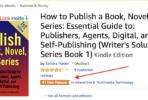The Scope (and Scoop) on Publishing

(an excerpt from “How to Publish a Book, Novel, or Series”)
The Slippery Slope of Publishing Terms
It seems simple enough: you write a story, publish it, and people read it.
Even the intermediate terms (printing, marketing, etc.) used in this process seem simple—but don’t be deceived: the terms can be slippery.
Today the publishing industry is adding terms (aggregators, boutique publishing, hybrids, etc.), while the previous words are morphing with new meanings.
What is Involved in Publishing:
Here is what you MUST know in order to understand this whole concept of publishing:
- Writing – Okay, you know this one: It involves a great deal of your time and effort, but the concept seems pretty simple: Write the story!
- Editing – This one word could mean any (or all) of several services, each of which is specific and distinct. Not every manuscript needs every level of edit, although every type of editing can serve an important purpose. Traditional publishers used to cover all these levels in one way or another. Some still do, but many now rely on the authors to already have these edits done. Self-publishing authors often skip some (or, sometimes, all) of these steps—which is really NOT a good idea!
- Developmental editing – This is also called structuralor substantive editing. It involves the structure of a story, like character development, pacing, story arc, audience, how everything functions together as a unit. This is structure-level editing.
- Beta testing – Not really editing at all, but this is often another step involved when considering revisions. This might be considered reader-level editing as it takes into account what readers, not editors, see as strengths and weaknesses in the story overall.
- Line Editing – Sometimes called stylistic editing. It involves evaluating the writing for clarity and flow. It can also involve moving sentences around so that your meaning is clear. This is paragraph-level editing.
- Copy Editing – also spelled copyediting, is sometimes the final editing that a manuscript goes through before its published. It involves grammar and punctuation and spelling. There are various style guides (most popular are the Associated Press Stylebook and The Chicago Book of Style) and each publisher will have its preferences and a stylesheet of their own as well. The copy editor will use that stylesheet as the final guide. This is sentence-level editing.
- Proofing – Also called proofreading, this kind of editing addresses typos, repeated words (like “the the”), spelling, punctuation and formatting issues. This word-level editing.
- Printing – This is strictly the act of turning your manuscript (today that would be a computer file of some sort) into a printed book or a downloadable e-book to read on an e-reading device.
- Distribution – This is delivering those printed books or e-books to sites (stores or websites) where readers can see and buy them.
- Marketing – This is announcing that the distribution is done and telling readers to find the book. Marketing involves anything from emails and newsletters to printed catalogs.
- Promotion – Promotions may include book fairs, guest spots on radio, television, or podcasts, or any direct contact with the public.
Wait … where is the term “publisher” in all this?
Actually publishers are involved in most, if not all, of these steps above.
Well, maybe. It depends on the route you take:
- Traditional publisher
- Small Press
- Hybrid or Co-op
- DIY Self-publishing
- Self-publishing with Assistance
Numerous options allow writers to pick and choose (and change their minds!) on the route to take for their book. In my next blog I’ll explain how writers can enjoy free, low-cost, or full-service providers to get ALL the self-publishing tasks handled.
Want personal help with your writing project?
Contact me directly with an email and let’s discuss YOUR book project!
Sandra Haven, Editor
Leave a comment:







